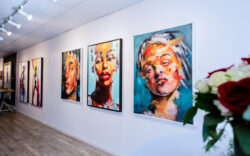The Role of the Studio
September 15, 2020Creative Endeavours and the Role of the Studio
What is the art studio? Some might see it solely as the place an artist reflects, researches, stores and produces material, but the potential of the space doesn’t need to end there. No matter how big or small, our working environment can be more than an area of inspiration and making – it can be the site where we propel our creative endeavours to the next level. With a bit of ingenuity, there are many ways an artist can adapt the studio to make it commercially viable. Three BC artists with three different approaches provide insight into the role of the studio, describing their own experiences and offering professional tips to those looking to draw more from their ‘imagination laboratory’.
Celebrated painter and teacher, Dene Croft, is president and senior member of the Federation of Canadian Artists. His extraordinary North Vancouver studio is a creative treasure trove, operating as an atelier and training ground for artists of all levels.
Yared Nigussu is an Ethiopian-born, internationally acclaimed artist, who’s widely celebrated for his large-scale, expressive work, energetic brushstrokes and flamboyant use of colour. In 2018 he launched his own gallery – ‘ART LAB – STUDIO’ – a creative hub to promote art and culture in Vancouver.
Granville Island-based abstract painter Amy Stewart’s canvases are full of unique explorations of colour and emotion. Her work, displayed and marketed in her studio is highly sought-after by interior designers. She sells internationally and frequently shows in galleries across Canada.
 DENE CROFT
DENE CROFT
As much as I may not like admitting it, I have become defined by my work over the years, and my studio is an integral part of my identity. It is a giant creative beehive and for the past 13 years, has grown from a traditional studio where I produced work for the galleries, to a creative space servicing over 1,000 student artists and aspiring professionals. It didn’t start out as anything entrepreneurial as such – it’s really become that way as a means to continue to support the creative community in one of the world’s priciest cities. The shift in the retail end of the fine arts market, coupled with a general trend towards self-representation, created the need for a large space to hold a collection of (currently) 150 paintings, and resulted in the studio functioning as a walk-in gallery. This has allowed me to create a stream of income from multiple sources which has ensured continued growth.

Remember that building a career (whatever that means to you) is a slow burn and a very long game – just keep pulling on that string and it will happen. Keep your overheads low. Painting in small spaces from home will do that. My first 70 paintings were painted from a spare bedroom studio, with one kid on my hip and one attempting to ‘finish’ my paintings – this was trench warfare. Become as social media-savvy as possible (I absolutely am not!), paint small and ‘affordable’ – your sweet spot will be between $300 and $800. Today you need to push your own barrow and market yourself. You have the tools to do it. The opportunities are boundless, but you need to know where to look for them. Get involved with your local arts community and leave no stone unturned. Find a mentor. Most successful people love to share their success, and love to share their knowledge. I do this every day and it is without any doubt the most satisfying part of my job.
 YARED NIGUSSU
YARED NIGUSSU
Early in my career, one of my clients came with his wife to visit me. When they arrived I was painting in my apartment. He asked, ‘Do you work here?’ and I said yes and he said, ‘Do you live here?’ and I said yes and he was like, ‘Ah okay… I will think about the purchase.’ And they left, without buying. They’d seen some of my work online but the way I presented it, it was not their dream, it was not what they were expecting and so they left. I thought I just wanted to be an artist and that I didn’t care about money, but of course, realistically, I was worrying about it. I was working a ten dollar per hour job, and I couldn’t even afford to go to the restaurant.
It took me three years but I eventually realised how important it was to make the business of art really enjoyable. An artist might be okay to work in a small, shabby, shared space, but that’s not necessarily what the buyers want to see. The client experience is essential. With that idea I started saving up and looking for a bigger space.


I want to have a profound connection with my clients and do this by inviting them to spend time with me in my studio. How cool is it to chill out with an artist, to share a cigar and a whiskey? That’s what I do. It’s all very personal. I also have an ‘Art Lab Experience’ package for companies who want to mingle and offer their employees some creative activity. I provide wine, canapés, entertainment and the chance to try some painting.
My advice to artists trying to make the most of their space is to go digital. Make sure that the place you’re capturing, even if it’s in the bedroom, is always presentable. Think about what images would impress you. This is your art and you need to advertise it. Set goals and always think about where you want to be next year. Only you can make your dreams come true.
 AMY STEWART
AMY STEWART
My studio is located on Granville Island and the neighbourhood is full of buskers, food, art, and industry, so it’s easy to take inspiration from the vitality around me. Being so immersed in the community allows my work to get noticed and my business to grow. I think it’s important that a studio reflects the artist. My studio walls are high, and with my paintings hanging all the way to the ceiling, the space feels like an extension of myself. I’ve put so much time into creating art here, and being surrounded by natural light and walls of my work has led me to regard my studio as my own little retreat. I use a really talented photographer to highlight the strengths of my space and to feature my paintings hanging in different settings.
My first commitment has always been to making art that moves me, but as a professional artist, it’s true that I have to take stock of certain business sensibilities. I frequently review the most popular canvas sizes, and I paint more of the types of works that sell most successfully. I also work hard to connect a narrative to the series I paint. As an abstract artist, I want my clients to have a story that enhances or focalizes some of the experiences that inform the pieces they purchase. That way, the emotional connection to the paintings strengthens, and my clients have a story to share with those who view my works in their homes.


It’s important to keep organized, whether you’re painting from home or a separate studio. I keep stations for my various supplies and for paintings at different stages of development. I schedule times for marketing (social media posts, gallery applications, communications with clients) and I set appointments with clients only on days when I’m not painting. On these days the focus is on the art pieces in their finished form, so I clean up my materials and any of the clutter I make on painting days. I transform my studio to display the artwork, and to allow for social distancing. Every once in a while, I hold an ‘open studio’ day. For these, I use social media to inform former and prospective clients (as well as the community at large) about the event. These events tend to bring in people who have been curious about my work, as well as passers-by who notice my signage. I also frequently post videos and images of my studio, inviting clients to make appointments to view pieces.
For more about the artists and their work, check out their websites and follow them on social media!
Dene Croft
Website: denecroft.com
Instagram: @denecroft
Yared Nigussu
Website: yarednigussu.com
Instagram: @yarednigussut
Amy Stewart
Website: amystewartartist.com
Instagram: @amystewartart
Facebook: @AmyStewartArt
